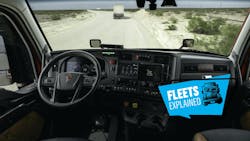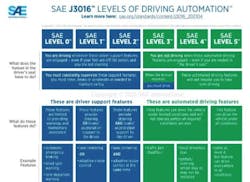Autonomous vehicles are a growing technology with significant implications for the transportation industry.
This is part of FleetOwner's Fleets Explained, a Trucking 101 series to break down aspects of the trucking and fleet management industries. You can read more from the series, launched in May 2024, at fleetowner.com/fleets-explained. To submit topic ideas, clarifications, and corrections, email [email protected].
An AV replaces some or all human input for operation. Adaptive cruise control, for example, is a low-level form of autonomous operation that conditionally replaces human input for dynamic speed control.
The technology is highly relevant for any transportation market. This is especially true for trucking, where human error, driver turnover, and hours-of-service regulations often set the limits of a truck’s income generation. Autonomous trucks are already transforming logistics operations.
See also: The current state of autonomous trucking
How do autonomous vehicles work?
AVs use an automated driving system to understand and react to a roadway’s conditions. The system interfaces with the vehicle using steer-by-wire and brake-by-wire technology.
An autonomous driving system observes its surroundings through several advanced sensors, including radar, cameras, lidar, and ultrasound. Sophisticated machine learning systems process these sensors’ feeds into actionable data, such as identifying pedestrians and gauging other vehicles’ behavior.
To understand their location, route, and destination, autonomous driving systems use radio communication to interface with satellites and navigation systems.
What are the levels of vehicle autonomy?
Vehicle autonomy is a spectrum. A modern vehicle can be more or less autonomous depending on how reliably it replaces human input.
The most common way of describing different types of autonomy is to reference the popular international standard. SAE International’s standard J3016, Taxonomy and Definitions for Terms Related to Driving Automation Systems for On-Road Motor Vehicles, outlines six levels of driving autonomy: from level zero (no autonomy) to level five (full autonomy).
Level 0 requires the driver’s complete vehicle control but still includes some advanced driver assistance technologies, such as automatic emergency braking, cruise control, and lane departure warnings, according to Fiast.
At Level 1, the driving system can control either direction or speed, but not both simultaneously. Level one includes more involved technologies, such as adaptive cruise control or lane-keeping assistance.
Level 2 grants the driving system control of both direction and speed control at the same time. Level two is the extent of Tesla’s self-driving features. Level 2 vehicles still require the operator's attention as these systems are not yet prepared for constant real-world operation.
Level 3 is the first degree of automation where a driver only needs to drive when the system requests. Honda sold the first Level 3 autonomous passenger vehicle in 2021.
Levels 4 and 5 continue to expand the autonomous system’s control. According to SAE, future vehicles under these levels might not even have pedals or steering wheels. Kodiak, Torc, and Aurora each have Level 4 autonomous trucks in operation. No Level 5 AV exists yet.
How autonomous vehicles fit in trucking
AV technology has the potential to greatly disrupt the trucking industry. Autonomous driving systems already operate heavy-duty commercial vehicles on public U.S. roadways.
The main use-case for autonomous trucks today is in middle-mile, hub-to-hub operations. The three major autonomous truck developers—Kodiak, Torc, and Aurora—each work toward a middle-mile model. McKinsey & Company projects that constrained, hub-to-hub operations are the first phase for AV trucking, potentially reaching full autonomy between distribution centers by 2040.
Self-driving trucks bring unique pros and cons that fleets should keep in mind.
The benefits of autonomous trucks
Autonomous trucks’ greatest benefit could be their potential to circumvent human limitations.
The autonomous driving system does not get tired like a human driver; it has fewer lapses in attention; it needs no federal labor protections like health care or a minimum wage. These human limitations significantly limit how much profit a truck can generate. AVs can make a carrier's equipment significantly more profitable because it can operate more.
Autonomous driving systems can be significantly more fuel efficient than human drivers. A study by now-defunct TuSimple found that self-driving tractors were 11% more fuel efficient and other AV companies saw similar efficiency gains. If a fleet spends $1 million on fuel, that means savings up to $100,000.
Autonomous driving systems may also be safer than human drivers—in some circumstances. Studies find that AVs can be significantly safer than human drivers when operating in rainy environments and during routine driving. Researchers from the University of Central Florida found that autonomous driving systems can detect objects from further away and react more quickly than human drivers.
The technology behind self-driving trucks will likely continue to improve in the future. The artificial intelligence behind autonomous vehicles is still relatively immature and has the potential to become significantly safer over time. As wireless communication becomes ubiquitous, driving systems may be able to instantly communicate with surrounding infrastructure and other vehicles, further boosting safety.
The drawbacks of autonomous trucks
AVs are an immature technology: modern AVs can introduce several negative consequences, from safety concerns to labor disputes.
AVs are not always safer than human drivers. AVs still face many environments where they cause more accidents than humans. In scenarios where a driving system was in poor lighting or was turning, the system proved several times more likely to crash than a human. Autonomous driving systems have trouble predicting human intent or learning gestures. However, these safety concerns are least relevant for middle-mile highway navigation.
Autonomous vehicles have security vulnerabilities. Bad actors could tamper with road signs or paint to mislead a vehicle. A vehicle’s CAN bus is vulnerable to hacks or tampering, which can be much more concerning if the vehicle operates without human input. Engineers with the National Motor Freight Traffic Association already proved that attackers can even wirelessly activate some tractor-trailers’ brakes.
While replacing human drivers is a benefit, it is also a major drawback. Though technology developers say that any professional truck drivers working today would reach retirement before AVs replace them, automation can lead to labor disputes, as seen with the conflict between a major union and East Coast ports.
Are autonomous trucks legal?
Autonomous trucks face a patchwork of regulations. There is no federal standard for autonomous vehicles yet; FMCSA has been working on autonomous vehicle rulemaking since 2019. Autonomous truck regulations only exist at the state level today.
About 24 states permit some degree of autonomous commercial vehicles, but their exact standards differ. The National Conference of State Legislatures maintains a robust database of states’ current AV legislation, both introduced and enacted.
See also: California shares draft regulations for heavy-duty AVs
Despite this patchwork, several companies operate autonomous trucks across the U.S. For example, Aurora operates self-driving trucks in Texas on Interstate 45 and Kodiak Robotics has completed more than 50,000 autonomously driven miles between South Carolina and Texas.
Autonomous truck regulations will likely continue to develop—and AV technology continue to improve—as the years roll by.
About the Author
Jeremy Wolfe
Editor
Editor Jeremy Wolfe joined the FleetOwner team in February 2024. He graduated from the University of Wisconsin-Stevens Point with majors in English and Philosophy. He previously served as Editor for Endeavor Business Media's Water Group publications.


